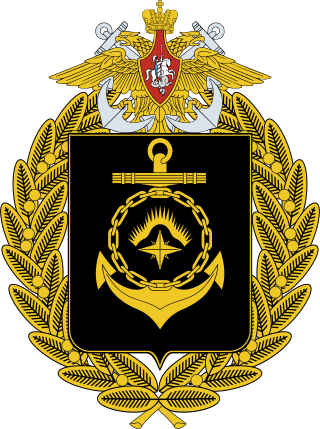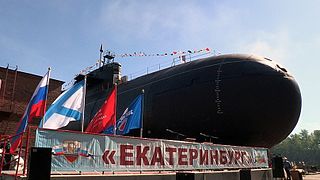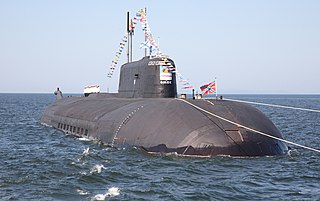Development and design
The design assignment was issued in 1969. The development of Project 949 was a new stage in the development of APRC-class submarines, which, in accordance with the concept of asymmetric response, were tasked with countering aircraft carrier strike formations. The new missile submarines were to replace the submarines of Projects 659 and 675 and in accordance with the terms of reference surpassed them in all basic parameters - could launch missiles from both surface and underwater position, had less noise, higher underwater speed, three times higher ammunition, missiles with radically improved combat capabilities. Project 949 became the pinnacle and the end of the development of highly specialized submarines (aircraft carrier killers).
In December 2011, they became known that the Rubin Central Design Bureau had developed a modernization project. It is planned to replace the P-700 missiles with the more modern P-800 Oniks missiles from the Caliber family. Modification of launch containers is planned, without alteration of the hull. The modernization of the nuclear submarine of the Northern Fleet will be carried out at the Zvezdochka CS, and the Zvezda shipyard. [3]
The design is double-hulled, with a distance between a light and durable body of 3.5 meters, which provides a significant buoyancy margin, up to 30%, and provides additional protection against underwater explosions. For their characteristic appearance, they received the nickname baton, [4] and for their powerful strike weapons they were nicknamed aircraft carrier killers. The robust housing is divided into ten internal compartments. [5]
Construction and career
The submarine was laid down on 25 February 1986 at Sevmash, Severodvinsk. Launched on 16 December 1988 and commissioned on 29 December 1989. [6] [7]
From 1990 to 1991, he was under repair in Severodvinsk.
On 3 June 1992, he was reclassified as a nuclear-powered submarine.
On 6 April 1993, he received the name Voronezh in connection with the establishment of the patronage of the administration of the city of Voronezh over it.
During his first combat service in the Mediterranean, the submarine supported the actions of a detachment of ships of the Russian Navy headed by the TAVKR Admiral of the Fleet of the Soviet Union Kuznetsov.
From 22 June to 26 June 1999, the cruiser took part in the Zapad-99 strategic command and staff exercises, during which she conducted practical missile firing.
In 2006, he arrived at the Zvyozdochka shipyard for emergency repair of the main turbine, as well as replacement of the cores of a nuclear reactor.
In December 2008, he was dry-docked. [7]
In March 2009, repairs and modernization began. [8] On May 26, after passing the course of restoration of technical readiness with elements of medium repair, launching and transfer to the outfitting embankment took place. [9]
In November 2011, based on the results of the work carried out, the service life of the cruiser was extended by 3.5 years.
The ship returned to its point of permanent deployment in March 2012. [10]
On 8 June 2014, Voronezh rescued the crew of the Barents-1100 small boat in the White Sea, which ran out of fuel while trying to bypass the area with unfavorable weather conditions. In September, while participating in tactical exercises of diverse forces of the Northern Fleet, the submarine performed single firing from a submerged position at a sea surface target with a Granit cruise missile. [11]
In October 2017, he successfully fired an anti-ship cruise missile Granit at a conditional target in the Novaya Zemlya archipelago area. [12]
He was put into reserve before decommissioning, and in July 2020 the name Voronezh was given to a new laid down nuclear submarine of Project 885M Yasen-M for the Northern Fleet. [13]
Pennant numbers
| Date | Pennant number [6] |
|---|
| 1991 | 629 |
| 1995 | 812 |

The Oscar class, Soviet designations Project 949 Granit and Project 949A Antey, are a series of nuclear-powered cruise missile submarines designed in the Soviet Union for the Soviet Navy. First built in the 1970s, six remain in service with the Russian Navy. Two other vessels were slated to be modernized since at least 2017 as Project 949AM, to extend their service life and increase combat capabilities but it is unclear whether work continues as of 2023.

K-407 Novomoskovsk is a Project 667BDRM Delfin-class ballistic missile submarine of the Russian Navy's Northern Fleet.

The Northern Fleet is the fleet of the Russian Navy in the Arctic.

Kirov is the lead ship of the Kirov class of nuclear-powered guided missile cruisers. Originally built for the Soviet Navy and passed onto the succeeding Russian Navy, she and her three sister ships are the largest and heaviest surface combatant warships built by them. The Soviet classification of the ship-type is "heavy nuclear-powered guided missile cruiser", nonetheless Kirov's size and weapons complement have earned her the unofficial designation of a battlecruiser throughout much of the world, as her size and displacement is similar to a typical World War I battleship. The appearance of the Kirov class was a significant factor in the U.S. Navy recommissioning the Iowa class. She was named after a Project 26 cruiser.

The Borei class, alternate transliteration Borey, Russian designation Project 955 Borei and Project 955A Borei-A, are a series of nuclear-powered ballistic missile submarines being constructed by Sevmash for the Russian Navy. The class is projected to replace the Soviet-era Delta III, Delta IV and Typhoon classes in Russian Navy service.

Pyotr Velikiy is the fourth Kirov-class battlecruiser of the Russian Navy. She was initially named Yuri Andropov after Yuri Andropov, the former General Secretary of the Communist Party, but the ship's name was changed after the fall of the Soviet Union. The Russian designation for the type is "heavy nuclear missile cruiser", but Western defense commentators have resurrected the term "battlecruiser" to describe them, as they are the largest surface "line of battle" warships in the world. Pyotr Velikiy is the flagship of the Northern Fleet.

The Russian cruiser Marshal Ustinov, is a Slava-class cruiser of the Russian Navy. The Russian name for the ship type is Raketnyy Kreyser (RKR), meaning "Missile Cruiser". The ship is named after Dmitriy Ustinov, a former Soviet Minister of Defence. Marshal Ustinov was assigned to the 43rd Missile Ship Division of the Russian Northern Fleet, whose homeport is in Severomorsk. From 2012 to 2016, the cruiser underwent a major overhaul. The vessel returned to service in 2017 and has since been deployed to the Mediterranean Sea.

The Sierra class, Soviet designations Project 945 Barrakuda and Project 945A Kondor,, are a series of nuclear-powered attack submarines intended for the Soviet Navy and currently in service with the Russian Navy.

The Yasen class, Russian designations Project 885 Yasen and Project 885M Yasen-M, also referred to as the Graney class, are a series of nuclear-powered cruise missile submarines designed by the Malakhit Marine Engineering Bureau and built by Sevmash for the Russian Navy. Design work commenced in earnest in the 1980s with the first submarine built in the 1990s–early 2010s with commissioning in 2013. Two additional boats to a modified Yasen-M design were commissioned in 2021 and six more are under construction. Based on the Akula class and Alfa class designs, the Yasen class is projected to replace the Russian Navy's current Soviet-era nuclear attack submarines. The Akula class is optimised for a hunter-killer role, whereas the Yasen class concept uses the platform as a nuclear guided missile submarine (SSGN).

K-560 Severodvinsk is a Yasen class nuclear-powered cruise missile submarine of the Russian Navy, and the lead vessel of the class. The submarine is named after the city of Severodvinsk. She is deployed with the Russian Northern Fleet.

K-561 Kazan is a Yasen-class nuclear-powered cruise missile submarine of the Russian Navy. It is the second boat of the project, separated from the first by 16 years (1993–2009). Considerable changes were made to the initial design. Differences in the project have appeared sufficient to consider it as a new upgraded version Yasen-M. The submarine is named after the city of Kazan. The submarine is deployed with the Russian Northern Fleet.

K-549 Knyaz Vladimir is a Borei-class nuclear-powered ballistic missile submarine, and the first upgraded Borei-A unit to enter service with the Russian Navy. The submarine is named after Knyaz Vladimir the Great.

K-84 Ekaterinburg is a Project 667BDRM Delfin-class nuclear-powered ballistic missile submarine. The submarine was laid down on 17 February 1982 at the Russian Northern Machine-Building Enterprise (Sevmash). It was commissioned into the Soviet Navy on 30 December 1985. After the collapse of the Soviet Union, the submarine continued to serve in the Russian Navy. Initially known only by its hull number, in February 1999 it was renamed after the city of Yekaterinburg.

K-114 Tula is a Project 667BDRM Delfin-class nuclear-powered ballistic missile submarine (SSBN). As such, she carries a complement of R-29RM Shtil and R-29RMU Sineva nuclear submarine-launched ballistic missiles (SLBM) as her primary deterrent mission, along with anti-ship missiles and torpedoes, the latter for self-defense. Built in Severodvinsk during the late 1980s, she served with the Soviet Navy before being transferred to the Russian Navy following the dissolution of the Soviet Union. Tula underwent an extensive overhaul during 2000–2004 and was fitted with upgraded Shtil SLBMs, several of which were launched from her during her later operational life. She was sponsored by the city of Tula, and is homeported in Gadzhiyevo.

K-266 Orel is a Project 949AM nuclear-powered cruise missile submarine (SSGN). She is one of three Oscar II submarines still serving in the Russian Northern Fleet, all assigned to the 11th Submarine Division, berthed at Guba Bolshaya Lopatka, on the Kola Peninsula northwest of Severomorsk.

The K-150 Tomsk is an Oscar-class submarine in the Russian Navy.

The K-186 Omsk is an Oscar-class submarine in the Russian Navy.

The K-410 Smolensk is an Oscar-class submarine in the Russian Navy.
The K-132 Irkutsk is an Oscar-class submarine in the Russian Navy.
This page is based on this
Wikipedia article Text is available under the
CC BY-SA 4.0 license; additional terms may apply.
Images, videos and audio are available under their respective licenses.















